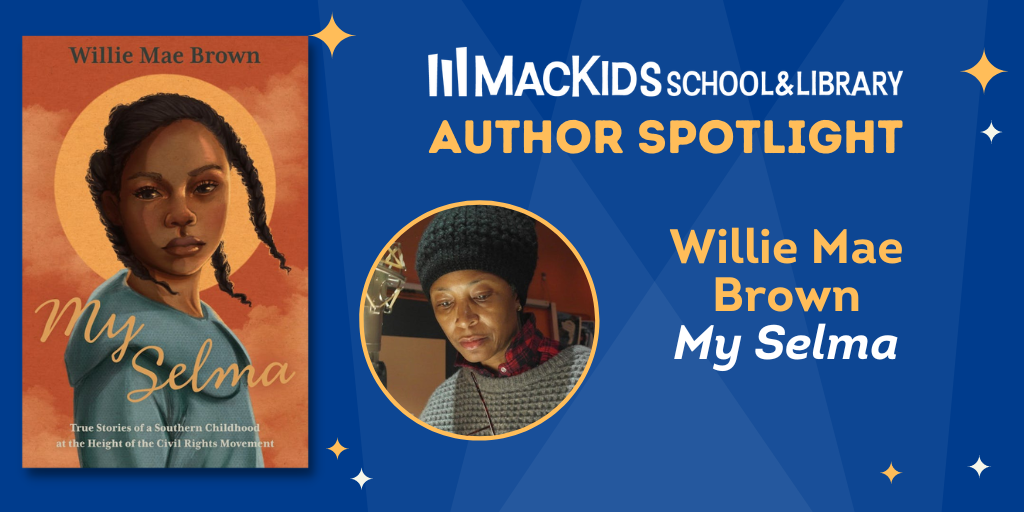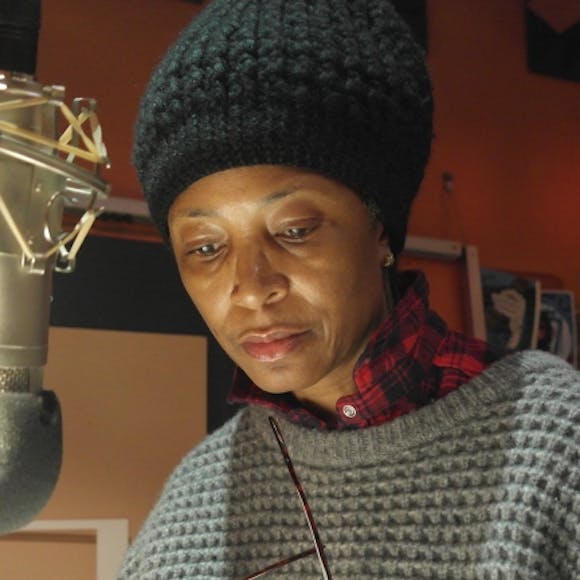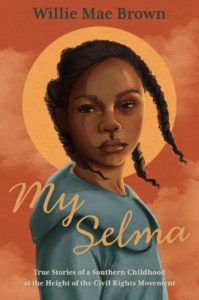MacKids Spotlight: Willie Mae Brown

Meet Willie Mae Brown, author of My Selma: True Stories of a Southern Childhood at the Height of the Civil Rights Movement. Combining family stories of the everyday and the extraordinary as seen through the eyes of her twelve-year-old self, Willie Mae Brown gives readers an unforgettable portrayal of her coming of age in a town at the crossroads of history.
In the preface you write, “I write about Selma because our lives have historical precedence in shaping the future. I write so that you may hear, see, smell, and feel the injustice of ignorance but also the sweetness of everyday life, illuminated in my words.” Alongside those beautiful words, can you start by telling the group what inspired you to write MY SELMA?
There was a need to write My Selma. Something had happened there and every-body that had lived there and was still alive, I felt they had an obligation to record what happened to them in their Selma doing the movement,fighting for their civil rights, their human rights and the right to vote. The movement itself was history. The people of Selma were the protagonists in the struggle for freedom,and voter rights. Yet why would they try to hinder me when I expressed the importance of writing a book or a story. “For what? They asked. Why would you do that, no one wants to hear about it. That’s over. Everybody knows what happened here.”Not only did southerners ask those questions of me, northerners did also.
I did not want the people to forget what they went through, how hard it was to get by and although it was hard ,there was always someone to hand them something of need. A good neighbor, a good church, beautiful land, and hope. I wanted them to remember the people who tried to break them and the people who locked arms with them. Those are stories. So I wrote them because it’s important.
What comes to mind when you think back on the fight for voting rights and the civil rights movement in Selma in 1965?
We didn’t have the technology that is now available. What we did have was knowledgeable people who were working with us such as The Student Nonviolent Coordinating Committee(SNCC)who organized sit-ins, and other actions based on nonviolence. Most of us were all of one mind, united. We were determined to overcome a prejudiced burden that had been put together by a race that was surely going to set us back even further than we were in 1965 had we not remained cohesive, nonviolent and secretive.
Tell us about a moment of joy and a moment of hardship from your childhood in Selma.
Being with my family, and friends just playing or riding bikes. losing my cousin to death was hard.
How do you hope this book will be used in classrooms and libraries?
My fervent wish is that this book with its stories will be a part of classroom history studies and appreciated by libraries, librarians to the point of suggesting student or readers to look back during a time when black people stood together in a small town in Alabama to overthrow a racist group of people who were bent on keeping them from becoming full- fledged citizens, not slaves in the United States of America in the twentieth century.
Tell us about a librarian or educator who made an impact on you.
Mrs. Brown was our librarian in middle school to high school. The books that she took care of and loaned to us were not the best books. The best books went to white schools, yet she employed us to take the best care of them.
What advice would you give to young writers?
Be a good detective, listen politely, observe what’s going on around you and take interest. Read and grow your book in your head.
What was your favorite book when you were a young reader?
Mary Shelley’s Frankenstein
ABOUT THE AUTHOR
ABOUT THE AUTHOR:

Willie Mae Brown left Alabama at the age of seventeen in 1970 to start a new life in Brooklyn, New York, where she worked for the New York Telephone Company until 2003. A visual artist as well as an author, she began writing stories about her childhood in 2012 and reading them in public in 2015. Known for infusing her personal narratives with the vernacular of her Southern upbringing, Brown has read at numerous public events including Martin Luther King Jr. Day celebrations at Brooklyn Borough Hall, as well as at many special events across the city, in her home state, and beyond. My Selma is her first book.
ABOUT THE BOOK:
My Selma
By Willie Mae Brown
On Sale 1/3/23
Combining family stories of the everyday and the extraordinary as seen through the eyes of her twelve-year-old self, Willie Mae Brown gives readers an unforgettable portrayal of her coming of age in a town at the crossroads of history.
As the civil rights movement and the fight for voter rights unfold in Selma, Alabama, many things happen inside and outside the Brown family’s home that do not have anything to do with the landmark 1965 march across the Edmund Pettus Bridge. Yet the famous outrages which unfold on that span form an inescapable backdrop in this collection of stories. In one, Willie Mae takes it upon herself to offer summer babysitting services to a glamorous single white mother—a secret she keeps from her parents that unravels with shocking results. In another, Willie Mae reluctantly joins her mother at a church rally, and is forever changed after hearing Martin Luther King Jr. deliver a defiant speech in spite of a court injunction.
Infused with the vernacular of her Southern upbringing, My Selma captures the voice and vision of a fascinating young person—perspicacious, impetuous, resourceful, and even mystical in her ways of seeing the world around her—who gifts us with a loving portrayal of her hometown while also delivering a no-holds-barred indictment of the time and place.
PRAISE FOR MY SELMA:
A Junior Library Guild Gold Standard Selection
“Vivid sensory language is the book’s great strength . . . A beautiful evocation of time and place . . . In her afterword, Brown says that ‘hope is in the telling,’ and her stories offer a strong voice still needed in the ongoing struggle for justice.” —The Horn Book
“Poignant . . . By balancing personal struggles with racism with everyday joys of community, family, and resilience, Brown authentically imbues this clear-eyed tale with salient detail and historical resonance.” —Publishers Weekly
“Brown uses language effectively to bring the times to life, and emerging from the retelling of her history are portraits of people who shaped her thought patterns and ways of being in her formative years. A panoramic yet intimate depiction of a family experiencing radical social changes.” —Kirkus Reviews



